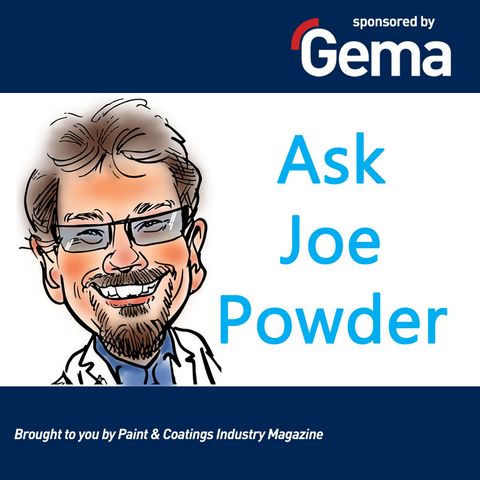
Ask Joe Powder
Gema is the proud sponsor of Paint & Coatings Industry (PCI) magazine’s “Ask Joe Powder” question & answer feature. If you have a question, simply email it to kevinbiller@yahoo.com and maybe your question will be on the pages of PCI magazine. Click here to see past issues of PCI magazine.
Gema Switzerland GmbH does not assume liability for the content of this page. The content is provided by Paint & Coatings Industry magazine.
Recent Questions
Question 1:
Hello Joe,
I am looking for insight on some samples that we cured for a potential customer. We are trying to cure a clear-coat epoxy. One process was cured with IR using quartz tubes at 70% power for 4 minutes. The second process was cured with IR for 2 minutes and then 10 minutes in a convection oven at 375 °F. The third process was cured fully in the convection oven for 18 minutes at 375 °F. Here’s the deal, all the IR-cured samples cracked, and the convection samples did not crack at all. We are thinking that we just cured too fast with the IR and “burned” the powder. We would greatly appreciate your thoughts and input..
Thanks, Mike
Wisconsin
Answer:
Hi Mike,
IR for a clear coat is tricky business. IR works best and most completely when the coating contains a pigment. With clear coats, here’s what happens: the dry powder absorbs heat from the IR until it melts. It then becomes transparent and essentially stops absorbing much more radiant energy. I suspect that the IR-cured sample is partially cured and hence the cracking.
If the substrate was a dark color, it would absorb more IR and affect further energy absorption, and hence, cure. However, clear coats are typically applied to bright metallic surfaces, which reflect rather than absorb IR energy. A good way to check is testing solvent resistance. Rub each sample with a rag soaked with acetone, MEK, or lacquer thinner. This will give you an idea of degree of cure. Let me know what you find.
Kind regards,
Joe
Question 2:
Dear Joe,
We coat wire shelving and baskets. We are using an epoxy/polyester hybrid powder. As the product line is 95% welded wire assemblies, is there a particle size that would lend itself to consistency of film thickness on the wire and the flat surfaces?
We currently experience high film build on the wire surfaces to assure specified film requirements on the flat substrate. While I know this is a phenomenon of electrostatics, will a particular particle size help?
John
Iowa
Answer:
Hello John, Particle size is critical for your end use. In fact, everything associated with your powder application system is critical. Let’s tackle the particle size issue first. You should specify a particle size distribution that is somewhat narrow, avoiding a high concentration of fines and coarse particles. On the low end, you want to have no more than 7% of your particles less than 10 microns. On the coarse side, you want nothing over 100 microns. This will give you a median particle size of roughly 35-40 microns.
Keep in mind that specifying particle size is tricky. Powder coating particle size fluctuates within a range during its production. Singular data points for a large batch of powder coating can be misleading. It is best to require statistical information for the batch, not just an average on these three critical parameters.
Other application parameters are equally important. Next on the list is ensuring that you have an adequate ground. You should have no more than 500 megohms resistance from the part to the ground – less is even better. This means you need to keep all connections (hooks, swivels, etc.) and contact points clean. Build-up not only hurts powder penetration, but it also can create a dangerous build-up of current that will eventually arc. Arcing can ignite a powder coating cloud with dire consequences.
Powder conveyance parts need to be clean and dry. This includes hoses, internal gun parts, powder venturies, and pick-up tubes. Regular cleaning will ensure consistent flow of powder from the fluidizing hopper to the gun tip. Speaking of gun tips, these need to be cleaned regularly to avoid excessive build-up and subsequent impairment of corona ionization.
Fluidizing hoppers need to be kept clean, dry, and properly maintained. The porous plate on the bottom of the hopper should be cleaned regularly with dry, oil-free compressed air. A combination of a refrigerated air dryer and air/oil separation filters must be in place and be regularly maintained. It's also very wise to keep meticulous logs of data for the powder you use and the application system performance. This helps you keep track of what works and provides useful data when troubleshooting. I hope that this helps.
Best regards,
Joe
Question 3:
Dear Joe,
We are in the process of establishing an assembly plant here in South Africa. Can an e-coated vehicle shell (body) be shipped overseas and painted at the destination?
If so, what would the processes be to implement something like this (i.e., paint shop)?.
Kind regards, Deon
South Africa
Answer:
Dear Deon,
Indeed, this process is quite feasible. In fact, it is a very good idea. It would be essential to thoroughly clean and prepare the electrocoated surface before applying the next coating. You would need to clean the surface to remove any soils deposited during transit and handling. A simple alkaline cleaner followed by a tap water rinse, then a deionized water rinse should suffice.
Sufficient drying before the next coating is applied would be the final step. This will provide a clean surface that will readily accept a powder coating.
Please let me know if I can be of further assistance.
Best regards,
Joe
Archives:
2023
2022
2021
2020
2019
2018
2017
2016
2015
